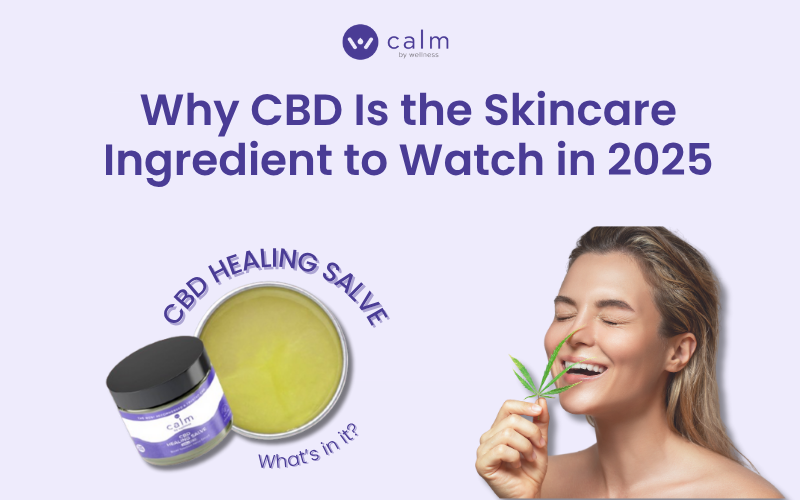CBD Tincture vs Topical: When to Use Each for the Best Results
CBD tincture vs topical — which one should you use, and when? Understanding the difference between these two forms of CBD is key to using

In 2025, CBD skin benefits are taking center stage in the beauty world. What began as a buzzword has evolved into a science-supported skincare solution that’s transforming how we treat inflammation, acne, dryness, and sensitivity. From facial serums to body balms, cannabidiol is proving its worth across a wide range of products. In this guide, we’ll explore the top ways CBD supports skin health, backed by research and real-world results.
Cannabidiol is a rich source of antioxidants, which counter free radicals from UV exposure, pollution, and stress—common accelerators of skin aging. A 2019 review confirms CBD’s powerful antioxidative action, which may delay skin aging and support collagen health. When paired with vitamin C or E, it’s a robust defense against premature lines and dullness.
Pro tip: Use a daytime CBD serum with vitamin C, and follow up with a nourishing CBD night cream to maximize multi-layered protection.
Research on sebocytes (oil-producing cells) shows CBD dose-dependently reduces sebum production and calms inflammation. Meanwhile, clinical trials find that topical CBD enhances hydration thanks to its botanical lipids and ability to lock in moisture. The result? Skin that’s dewy and comfortable; not oily or dry.
Choose gel-cream or serum-based CBD options for balance, or richer textures at night if your skin tends to be dry.
Acne stems from excess oil, inflammation, and bacterial colonization. CBD addresses all three: it suppresses lipid overproduction, inhibits inflammatory cytokines (e.g., TNF‑α, IL‑1β), and exhibits mild antimicrobial effects. A 2024 study praised CBD’s “multifaceted” anti-acne effects.
Routine tip: Add a CBD serum or gel after cleansing—especially post-salicylic acid treatments—to calm reddened, inflamed areas gently and reduce downtime.
CBD interacts with the endocannabinoid system to inhibit inflammatory pathways like TRPV1 and JAK/STAT, cutting levels of TNF‑α, IL‑1, and IL‑6. This explains why CBD topicals are effective against eczema, rosacea, and psoriasis. A Verywell Health summary also highlights its success in reducing itch, redness and enhancing wound healing.
For reactive or sensitive skin, choose CBD lotions infused with calming allies like aloe, chamomile, or oat extract.
Experimental models show topically applied CBD accelerates wound closure, promotes collagen formation, and reduces inflammatory infiltration. Nano-encapsulated CBD even shows promise in protecting DNA from UV damage—supporting repair post sun or post-procedure.
Pro tip: Apply a CBD balm or cream after microneedling or chemical peels or to soothe post-inflammatory marks.
Chronic skin conditions like eczema and psoriasis benefit from CBD’s anti‑inflammatory, barrier-supporting properties. CBD reduces dryness and itch, hydrates skin through barrier protection, and delivers sustained soothing relief. User feedback also credits CBD for calming flares and enhancing barrier function.
Look for formulations with ceramides, oatmeal, or glycerin alongside CBD to support those living with eczema or dermatitis.
By extinguishing inflammation, reducing oxidative stress, and helping maintain moisture, CBD can gradually cultivate brighter, more even skin tone. Clinical data support its role in minimizing redness and dullness. Brands are combining CBD with niacinamide, licorice root, or vitamin C to maximize evenness and luminosity.
Routine tip: Use a brightening CBD sheet mask or weekly serum boost to restore clarity and radiance after sun exposure or long weeks.
From its soothing powers to oil-balancing effects and antioxidant strength, CBD has earned its spot in the 2025 skincare spotlight. As research grows, it’s clear that cannabidiol isn’t just another passing trend; it’s a versatile, skin-supportive ingredient backed by real science.
Before adding it to your routine, make sure to choose high-quality, third-party-tested products and consult your dermatologist if you have underlying skin conditions.
CBD tincture vs topical — which one should you use, and when? Understanding the difference between these two forms of CBD is key to using
Why CBD Delivery Methods Matter CBD is widely used for relief from stress, sleep issues, and chronic pain. But not all CBD products work the
CBD products are everywhere, but can you really trust the label? Knowing how to read CBD oil labels gives you the power to choose quality
Struggling to fall or stay asleep is a challenge that affects millions. As stress, screen time, and lifestyle habits disrupt natural rhythms, many people are

As climate change intensifies, extreme heat safety for older adults has become a critical public health priority. Aging bodies are less able to regulate temperature,

Calm by Wellness is the most recommended CBD & Delta-8 oil in the world. Trust our verified 5 star reviews and testimonials. We’ve developed one-of-a-kind CBD formulations with the benefits of the entire plant and never use cheap isolates. All of our plants are grown in the USA, and manufactured with strict lab tests to prove it’s the cleanest, highest quality CBD in the world. Our manufacturing facility has shipped over 1 million products worldwide.
Calm by Wellness
609 Deep Valley Dr. Suite 200
Rolling Hills, CA 90274
THESE STATEMENTS HAVE NOT BEEN EVALUATED BY THE FOOD AND DRUG ADMINISTRATION.
THIS PRODUCT IS NOT INTENDED TO DIAGNOSE, TREAT, CURE, OR PREVENT ANY DISEASE.

Calm by Wellness is the most recommended hemp CBD oil in the world. Trust our verified 5 star reviews and testimonials. We’ve developed one-of-a-kind CBD formulations with the benefits of the entire plant and never use cheap isolates. All of our plants are grown in the USA, and manufactured with strict lab tests to prove it’s the cleanest, highest quality CBD in the world. Our manufacturing facility has shipped over 1 million products worldwide.
Calm by Wellness
609 Deep Valley Dr. Suite 200
Rolling Hills, CA 90274
[email protected]
THESE STATEMENTS HAVE NOT BEEN EVALUATED BY THE FOOD AND DRUG ADMINISTRATION.
THIS PRODUCT IS NOT INTENDED TO DIAGNOSE, TREAT, CURE, OR PREVENT ANY DISEASE.